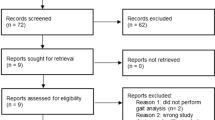Abstract
Purpose
Limb salvage surgery is increasingly used for the treatment of distal femur bone sarcomas. Total knee replacement using megaprosthesis and epiphysis-sparing biologic reconstruction using an allograft are widely used in order to preserve joint motion. We aimed to compare the results of these procedures using gait analysis in patients undergoing limb salvage surgery.
Methods
Fifteen patients were included, nine undergoing allograft with epiphysis sparing (Allograft group) and six undergoing megaprosthesis (Megaprosthesis group). Every patient underwent a gait analysis using the Plug-in-Gait protocol. Spatiotemporal parameters, knee kinematics, and kinetics were compared between the two groups and a cohort of ten asymptomatic subjects. Knee function was assessed by the Gait Deviation Index (GDI) and the Gilette Gait Index (GGI).
Results
Both treatment groups showed decreased knee flexion during the loading response phase. Megaprosthesis patients showed a decreased knee flexion all along stance phase. There was no difference in gait pattern between the treatment groups. GDI was significantly lower in Megaprosthesis and Allograft patients when compared to controls (86.4 and 84.3 vs 94, all p < 0.05). This difference was not clinically relevant.
Conclusion
Our study reveals that Megaprosthesis and Allograft patients did not show differences in gait patterns and global function. Even though Allograft and Megaprosthesis patients have significant changes in gait pattern, knee function is acceptable with effective gait mechanisms. Changes occur during stance phase and are due to the quadriceps weakness. The particular pattern of gait in Megaprosthesis patients could be a concern for prosthesis wear and should be investigated on this specific aspect.
Level of evidence: 4





Similar content being viewed by others
References
Schrager J, Patzer RE, Mink PJ et al (2011) Survival outcomes of pediatric osteosarcoma and Ewing’s sarcoma: a comparison of surgery type within the SEER database, 1988-2007. J Registry Manag 38:153–161
Okita Y, Tatematsu N, Nagai K et al (2013) Compensation by nonoperated joints in the lower limbs during walking after endoprosthetic knee replacement following bone tumor resection. Clin Biomech (Bristol, Avon) 28:898–903. https://doi.org/10.1016/j.clinbiomech.2013.08.005
Bruns J, Raabe K, Deuretzbacher G (2016) Gait analysis in tumor patients after distal femoral resection and implantation of a megaprosthesis. Acta Orthop Belg 82:287–297
Carty CP, Bennett MB, Dickinson IC, Steadman P (2009) Assessment of kinematic and kinetic patterns following limb salvage procedures for bone sarcoma. Gait Posture 30:547–551. https://doi.org/10.1016/j.gaitpost.2009.08.234
Carty CP, Dickinson IC, Watts MC et al (2009) Impairment and disability following limb salvage procedures for bone sarcoma. Knee 16:405–408. https://doi.org/10.1016/j.knee.2009.02.006
Capanna R, Ruggieri P, Biagini R et al (1991) The effect of quadriceps excision on functional results after distal femoral resection and prosthetic replacement of bone tumors. Clin Orthop Relat Res:186–196
Saunders J, Inman VT, Eberhart H (1953) The major determinants in normal and pathological gait. J Bone Joint Surg Am 35:543–558
Riley PO, Paolini G, Della Croce U et al (2007) A kinematic and kinetic comparison of overground and treadmill walking in healthy subjects. Gait Posture 26:17–24. https://doi.org/10.1016/j.gaitpost.2006.07.003
Kainz H, Graham D, Edwards J et al (2017) Reliability of four models for clinical gait analysis. Gait Posture 54:325–331. https://doi.org/10.1016/j.gaitpost.2017.04.001
Ollivier M, Parratte S, Lunebourg A et al (2016) The John Insall award: no functional benefit after unicompartmental knee arthroplasty performed with patient-specific instrumentation: a randomized trial. Clin Orthop Relat Res 474:60–68. https://doi.org/10.1007/s11999-015-4259-0
Kadaba MP, Ramakrishnan HK, Wootten ME (1990) Measurement of lower extremity kinematics during level walking. J Orthop Res 8:383–392. https://doi.org/10.1002/jor.1100080310
Davis RB, Õunpuu S, Tyburski D, Gage JR (1991) A gait analysis data collection and reduction technique. Hum Mov Sci 10:575–587. https://doi.org/10.1016/0167-9457(91)90046-Z
Loudon J, Swift M, Bell S (2008) The clinical orthopedic assessment guide. The Clinical Orthopedic Assessment Guide, 2nd edition. Human Kinetics, pp 395–408
Schwartz MH, Rozumalski A (2008) The gait deviation index: a new comprehensive index of gait pathology. Gait Posture 28:351–357. https://doi.org/10.1016/j.gaitpost.2008.05.001
Schutte LM, Narayanan U, Stout JL et al (2000) An index for quantifying deviations from normal gait. Gait Posture 11:25–31
Aponte-Tinao L, Ayerza MA, Muscolo DL, Farfalli GL (2015) Survival, recurrence, and function after epiphyseal preservation and allograft reconstruction in osteosarcoma of the knee. Clin Orthop Relat Res 473:1789–1796. https://doi.org/10.1007/s11999-014-4028-5
Correa KP, Devetak GF, Martello SK et al (2017) Reliability and minimum detectable change of the gait deviation index (GDI) in post-stroke patients. Gait Posture 53:29–34. https://doi.org/10.1016/j.gaitpost.2016.12.012
Colangeli M, Donati D, Benedetti MG et al (2007) Total knee replacement versus osteochondral allograft in proximal tibia bone tumours. Int Orthop 31:823–829. https://doi.org/10.1007/s00264-006-0256-y
Perry J (1990) Pathologic gait. Instr Course Lect 39:325–331
Benedetti MG, Bonatti E, Malfitano C, Donati D (2013) Comparison of allograft-prosthetic composite reconstruction and modular prosthetic replacement in proximal femur bone tumors: functional assessment by gait analysis in 20 patients. Acta Orthop 84:218–223. https://doi.org/10.3109/17453674.2013.773119
Rompen JC, Ham SJ, Halbertsma JPK, van Horn JR (2002) Gait and function in patients with a femoral endoprosthesis after tumor resection: 18 patients evaluated 12 years after surgery. Acta Orthop Scand 73:439–446. https://doi.org/10.1080/00016470216319
D’Lima DD, Fregly BJ, Patil S et al (2012) Knee joint forces: prediction, measurement, and significance. Proc Inst Mech Eng Part H J Eng Med 226:95–102. https://doi.org/10.1177/0954411911433372
Acknowledgements
Authors declare no conflict of interest regarding this article.
SP received a grant from SOFCOT, SOFOP and ADEREM for this work
Author information
Authors and Affiliations
Corresponding author
Rights and permissions
About this article
Cite this article
Pesenti, S., Peltier, E., Pomero, V. et al. Knee function after limb salvage surgery for malignant bone tumor: comparison of megaprosthesis and distal femur allograft with epiphysis sparing. International Orthopaedics (SICOT) 42, 427–436 (2018). https://doi.org/10.1007/s00264-017-3608-x
Received:
Accepted:
Published:
Issue Date:
DOI: https://doi.org/10.1007/s00264-017-3608-x




